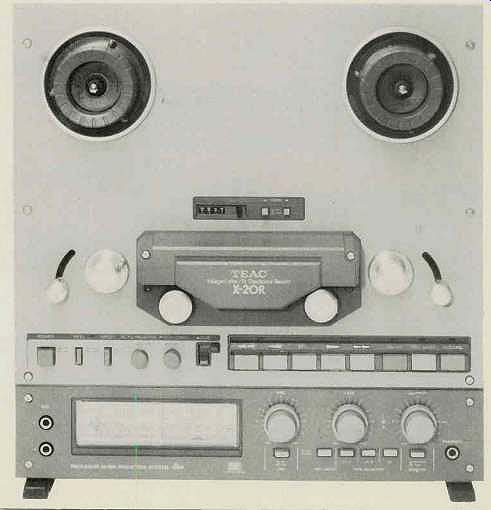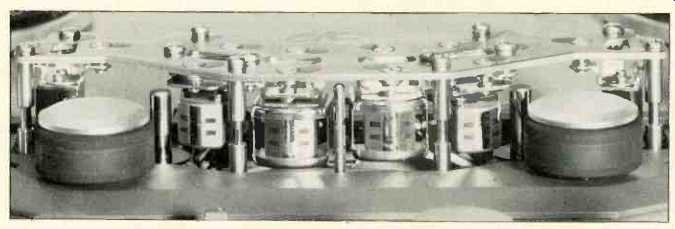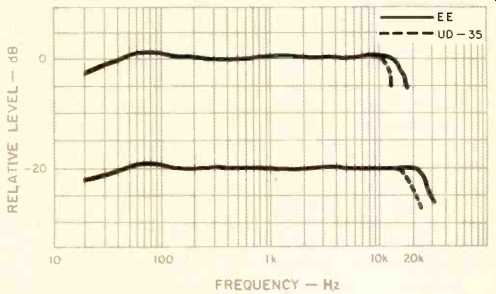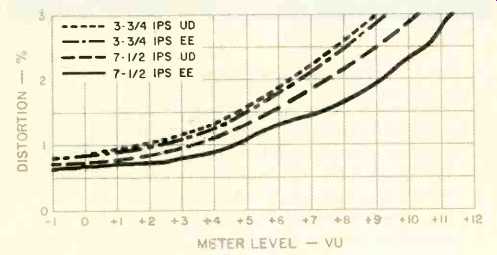
Manufacturer's Specifications:
Type: Quarter-track, bidirectional.
Speeds: 3 3/4 & 7 1/2 ips.
Wow & Flutter: 0.03% at 3% ips and 0.04% at 7 1/2 ips, wtd. rms.
Frequency Response: 30 Hz to 28 kHz ± 3 dB at-10 VU, 7 1/2 ips; 30 Hz to 16 kHz ±-3 dB, 3 3/4 ips.
Distortion: 0.8% at 0 VU.
Signal-to-Noise Ratio: 63 dB; with dbx, 100 dB.
Crosstalk: 50 dB at 1 kHz.
Dimensions: 17 in. (43.18 cm) W x 18 in. (45.72 cm) H x 9 in. (22.86 cm) D.
Price: $1,400.00.

When quality cassette decks came along, many experts were quick to prophesy the early demise of open-reel machines but here they are, nearly 20 years later, alive and well. In the last Audio Equipment Directory, there were some 46 machines listed from 14 manufacturers. Although cassette decks have improved enormously over the past few years, open-reel models still offer many advantages. Headroom over the whole band is better, frequency response is wider, and then there is the ability to edit.
Signal-to-noise ratios are around 65 dB without noise-reduction systems, and if a dbx unit is employed, as it is here, you have a dynamic range capability of 100 dB!

Table I --Signal-to-noise ratios vs. tape speed and tape type. ("A" weighted,
re: 3% THD; all tapes are from Maxell.)
At the present time, few machines have a dbx system actually built-in. One of them, however, is TEAC's X-20R deck which is a quarter-track model with bidirectional record and playback capability. It features a monitor head, full-logic controls, provision for large reels, and a pitch control. The front panel measures 17 inches wide by 18 inches high, including the feet, and it is finished in gray with a brown subpanel at the bottom. Two large VU meters are on the left of this small panel, and three dual-concentric controls are located to the right. The first knob is for microphones, the second controls the line input, and the third is the output control. Underneath are pushbutton switches, one each for dbx noise reduction and Rec Mute, three for tape selection, and then one for tape/source monitoring. Microphone sockets are at the extreme left, while the phone jack is over on the right. Above the VU meters on the main panel are the following switches: On-off, small/large reels, speeds (3 3/4 or 7 1/2 ips), auto-reverse, pitch, and a lever marked Cue. This last disengages the tape lifters in the fast wind or pause modes so the user can listen for the beginning or end of a particular selection.
Next to the Cue lever is a line of tape transport pushbuttons which include a Pause button, one marked Rec Mute and, right at the end, one marked Record. There are, in fact, two Record buttons but I'll explain that later. Above the tape head assembly is a digital counter and two timer buttons --one for each tape direction. There are three motors, and the transport system uses a dual-capstan closed-loop drive. This kind of system isolates the tape from tension produced in the reels, and the stability is usually better because the length of unsupported tape is kept to a minimum. The capstan shaft is kept in firm contact with the thrust bearings by an arrangement of two magnets TEAC calls "Magnafloat." Thus, the capstans maintain a precise axial relationship to the tape without the use of springs or pressure plates. Input and output sockets are in a convenient angled recess at the rear, together with a multi-socket for a remote-control unit, Model RC-100.
This is one of the first machines offered with the ability to handle the new EE or extra efficiency open-reel tapes, which can be thought of as chrome or chrome-equivalent tapes for such decks. As we will see later, there is a significant improvement in both headroom and frequency response in such a machine, so that slower speeds can be used with quite good results. Since open-reel tapes are not inexpensive, this can pro duce a real savings in tape costs, as well as making for ease in recording because the setting of levels is not so critical.

Fig. 1- Record-replay response at 3 3/4 ips.

Fig. 2- Record-replay response at 7 1/2 ips.

Fig. 3- Distortion and headroom at 1 kHz.

Fig. 4 --Distortion vs frequency.
Measurements
The playback response with standard test tapes was within ±1 dB from 40 Hz to 18 kHz at 7 1/2 ips and within ±2 dB from 40 Hz to 12 kHz at 3% ips, showing the normal slight rise at the high end. As mentioned above, the X-20R is one of the first machines designed to take advantage of the new EE tapes, so this was the kind used for most of the tests. The type selected was Maxell XL II 35-90, and it was compared with a standard Maxell high-efficiency formulation (UD 35-90). Figure 1 shows that the EE tape extended the 0 VU response from 12 to 16 kHz and the-20 VU response from 19 to 24 kHz. At 7 1/2 ips (Fig. 2) the gain was from 19 to 23.5 kHz and from 28 to 33.5 kHz.
Headroom at 1 kHz can be seen in Fig. 3: Note that 0 VU is at 185 nWb/m and that there is 8 to 11 dB headroom.
Distortion versus frequency is shown in Fig. 4, and these measurements were made at 0 VU, not at-10 dB. It looks as if the claim that "EE tapes can increase the response at 3 3/4 ips to equal the response of ordinary tapes at 7 1/2 ips" is a reasonable one. However, I found that the gain in signal-to-noise ratios to be just as important, and the figures are given in Table I. Switching in the dbx system increased these figures by about 40 dB. The expansion ratio is the standard 2:1 -- the same as for the dbx encoded records. However, no provision is made for using the unit for records--which seems a pity, though, curiously enough, a switch for this purpose is provided on TEAC dbx cassette decks!
But here are some more figures: Input required for 0 VU was 73 mV line and 0.23 mV for microphone. Output varied be tween 600 and 700 mV, depending on the kind of tape used.
Maximum signal handling capacity at the microphone inputs was 27 mV. Signal-to-noise ratio decreased by 6 to 7 dB when a microphone was connected. Wow and flutter measured 0.02% at 7'/2 ips and 0.035% at 34'4 ips (DIN 45-507). Rewind time was 62 seconds for an 1800-ft. reel. The pitch control gave a variation of ±6%. Crosstalk was better than 50 dB at 1 kHz and 40 dB at 10 kHz. Erase efficiency was better than 70 dB. Finally, the VU meter ballistics were checked and found to be within 0.5 dB of the ANSI standard response for 300-mS pulses.
Use and Listening Tests
The procedure for recording is as follows: Having selected the correct position for the tape selector buttons, the Rec Mode button is pushed. The indicator located just above the red Record tape-transport button will now show a flashing light, so the next step is to depress this button at the same time as one of the two Play buttons. If so desired, the Pause button can be pressed and the input levels checked before actually commencing recording. If a mode change is made during recording or playback, the tape motion stops and there is a 5-second delay before the new mode starts to operate. Thus, the tape can be switched from slow to fast speeds, forward to reverse without any danger of the tape breaking.
I found the machine a real delight to use: The logic controls worked smoothly, with a nice professional feel, while the VU meters were remarkably accurate. The above-average head room--especially with EE tape--is a definite plus, as is the convenience of bidirectional operation. And then there is the dbx facility with its almost incredible 100-dB-plus range. I made a number of dbx recordings and found that the best results were obtained with the VU meters kept below the 0 mark on peaks. If the signals were peaking in the +2 or +3 dB range, a slight breathing effect could be heard. I imagine most readers will have heard a dbx system at one time or another, but for those who haven't, the tremendous dynamic range and dead quiet back ground will be a revelation.
--George W. Tillett
=================
(Adapted from Audio magazine, Mar. 1982)
Also see:
TEAC 3340 Open-reel tape recorder (Mar. 1973)
TEAC Model C-1 Cassette Deck (Dec. 1979)
Technics by Panasonic Quadraphonic Tape Recorder Model RS-740US (Jul. 1973)
Technics SV-P100 Digital Audio Cassette Recorder (Apr. 1982)
Technics Model RS-616 Cassette Deck (Feb. 1979)
= = = =